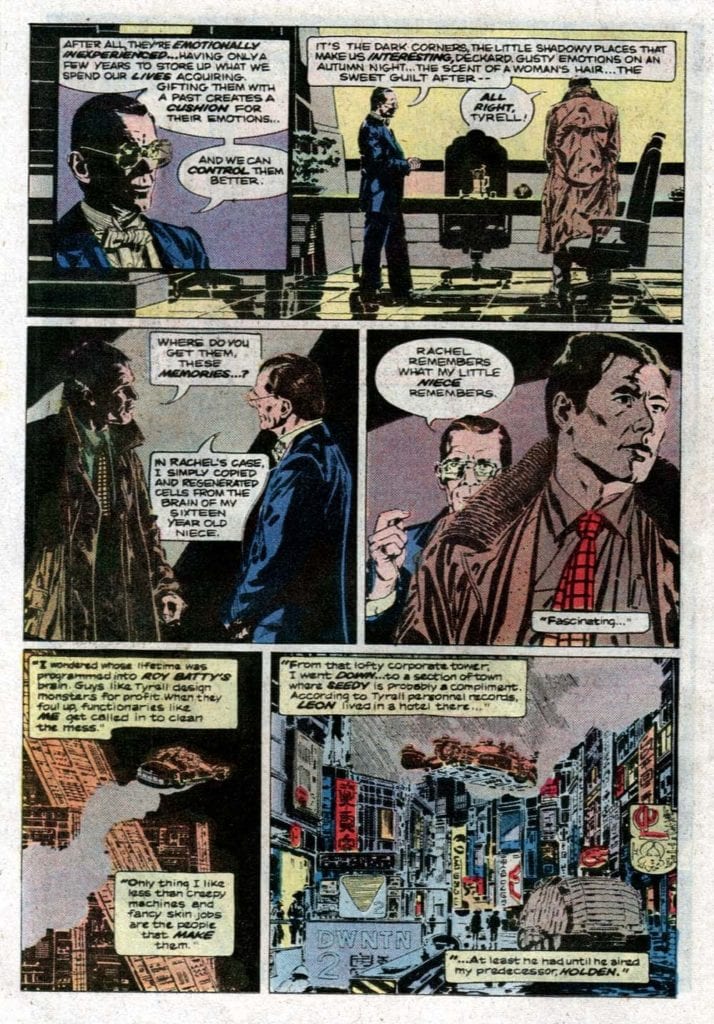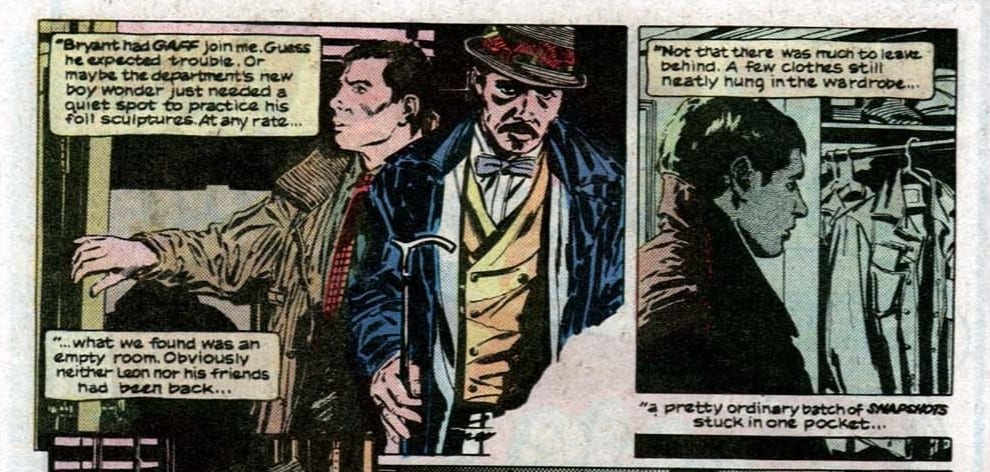Just like any medium there are a number of elements that make up a comic. Some are essential; some relate only to the comics medium; some are artist extravagance. Elements fall in and out of favour and others are more suited to a particular genre.
When the modern American comic first became popular there was an element that most readers would recognise: The Caption Box. The Caption was most often used to provide the narration for the story, a voice-over or, on occasion, an inner monologue. Pick up any genre of comic in the 1940’s and 50’s and the Caption would have been readily used. Everything from pulp fictions, through horror and romance titles, and on into the superhero comic, Captions were a mainstay of comic book storytelling.
These days the Caption is less widely used and its purpose changes depending on the genre of comic. More weight is given to the art on a page that the need for a narrator has diminished greatly. You only need to look at the modern Superhero comic to see how Captions have changed. Once they were descriptive, telling the reader what was happening. These days they are mostly inner thoughts or emotional reactions of a character.
MFR ON YOUTUBE (latest video)
Help us reach 5K Subs!
The use of Captions depends on a number of factors, including but not limited to, genre, storytelling, artistic style. Over the last 100 years the reliance on Captions has diminished. To truly appreciate this you have to understand the uses in the first place, and recognise the differences between narrative and emotive scripting.

Blade Runner
Before I start to look at the use of the Caption within the Blade Runner comic I am going to define their purposes with the help of the movie. Or to be more precise, the movie’s original theatrical release.
After Ridley Scott delivered the movie to the studio, a poor test audience reaction resulted in the inclusion of a post production voice-over recorded by the star, Harrison Ford. The following two scenes are of significance and, in a way, illustrate the points I am going to make later on.
The first scene involves Deckard hunting down the Replicant Leon. He is travelling in his squad car, listening to an interview where the killer reveals his home address. Cut scene to Deckard and Gaff entering a hotel room. The voice-over states:
“I didn’t know whether Leon gave Holden a legit address. But it was the only lead I had, so I checked it out.”
The next scene I want to look at is at the very end of the movie. Deckard and Rachel have left his apartment to run away together, away from the city and away from the Blade Runners. As Deckard heads towards the elevator he discovers a small origami unicorn on the floor. Picking it up he remembers the words Gaff, who has been making origami creatures throughout the film, spoke to him in the previous scene, ‘It’s too bad she won’t live’. As Deckard and Rachel drive away into the idyllic countryside the voice-over informs the viewers:
“Gaff had been there, and let her live. Four years, he figured. He was wrong. Tyrell had told me Rachel was special: no termination date.”
The voice-over for both of these scenes does essentially the same thing and is unnecessary in both cases. In scene one Deckard is telling the audience what is currently happening, they are entering Leon’s home, but this was already established at the end of the previous scene. In fact the previous scene exists as a transition into the hotel investigation. In the second scene Deckard is informing us what has just happened, confirming that Gaff left the unicorn after having been at the apartment. Again this is unnecessary because the act of picking the origami unicorn up, mixed with the flashback of Gaff’s voice, gives the audience all of the information they need to work out what happened.
Both instances, and in fact the majority of the voice-overs in the film, serve no purpose other than to explain what is going on in the visual element of the movie. There is no stylistic or narrative enhancements provided by Ford’s halfhearted tones and pointless words. They belittle the visual storytelling and assume the audience doesn’t understand what they are seeing. It’s inclusion in the film illustrates a poor misunderstanding of the target audience and in the end makes the final product less than what it is.
And that leads us into the use of Captions with a Comic Book

Comic/Movie Comparison
In the 1982 Marvel Comic adaptation of the movie, written by Archie Goodwin and pencilled by Al Williamson and Carlos Garzon, the two scenes mentioned above are quite different. The comic itself contains considerably more voice-over and this primarily takes the form of Captions, filling the pages. Every detail of Deckard’s thought process is brought out via his inner monologue, displayed in the caption boxes.
In the first scene example, the monologue in the comic leads the reader across the bottom of the page, relaying the information that Deckard has received in order to find Leon. It acts partially like the computer recording in the movie version but also expresses the differences between the rich, powerful Tyrell Corporation and the destitute living conditions of the poor workers. The images in the panels do not reflect the rich/poor divide as clearly as they could, instead focusing on the cinematic visuals from Scott’s movie vision. However, the panels don’t need to carry this weight because the narration does.
After the page turn, the voice-over continues but instead of just telling the reader what is happening, as in the movie version, it gives us more detail. It includes character development, with it’s mention of Gaff, and sets a more detailed scene. It expands on the images that the panels portray to create a fuller experience.
The Captions have more of a narrative function than the voice-over in the film. You just need to look at the final page of the comic to see this. Deckard’s final words are an expansion of his character and how far he has travelled through the story. His relationship with Rachel and his outlook on life itself has been affected and this comes out through his thoughts. It goes way beyond explaining what the audience is looking at or what it means. In fact, it only hints at and insinuates what happened at the end, outside Deckard’s apartment.
This ending displays another purpose of Captions: a reflection of style. Blade Runner is seen as a neo- noir movie and links are made to classic pulp fiction films and novels of the 1940/50’s. However, the film, especially in it’s Directors cut version, leans more towards a science fiction thriller rather than a detective mystery. Although the elements of a Raymond Chandler novel are there, this isn’t a Philip Marlowe hard-boiled adventure. The comic, however, leans much further into this kind of narrative. It sets a tone more in line with a classic private eye tale, creating claustrophobic inner city scenes of deprivation and hopelessness. J F Sebastian’s apartment feels much smaller in the comic compared to the vast floor space depicted in the film. Even the interior of the Tyrell Corporation is scaled down to produce more intimate confrontations.
In short, Deckard’s inner monologue, lettered beautifully throughout by Ed King, fits with the stylistic visual choices made by the artists. The aesthetics, the pace, and ultimately the narrative, is more akin to a Chandler or Hammett novel. The movie is a visual treat but the comic really works the narrative gears.

Narrative Versus Style
Within the pages of the Blade Runner comic adaptation, Captions are used to tell the story and enhance the themes and style of the overall comic. Everything you need to know about the use of Captions in comics can be found in these pages, especially when compared to the movie version. There are elements of narrative progression, atmospheric setting, and stylistic interpretation. This 1984 comic bridges the gap between the more functional use of Captions in the 1940s and 50s and the stylistic approach of modern comics.
An array of comics have used Captions for different purposes but ultimately they come down to one of two main functions: Style and Narrative. They either set the mood for the reader or help to move the narrative forward. Genres such as Crime and Suspense are more inclined towards the use of Captions but the technique is still widely used, albeit with a different intent to those early American comics published by the likes of EC Comics.

